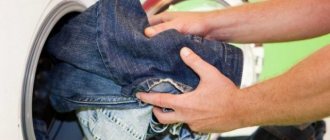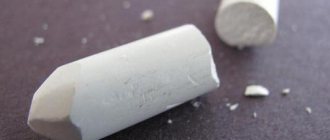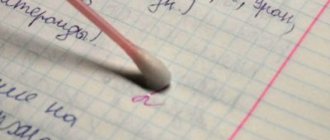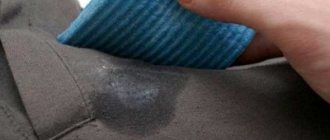Method 1 - blotter
Since blotting pads are made of a material that absorbs moisture and liquids well, they are good for removing fresh grease marks. Application is very simple. Place the blotter on the problem area and iron with a warm iron. Change consumables as they become saturated with fat.
If you don't have blotter pads in your house, use paper napkins. Use only white napkins. This method can be used for documents, sheets of paper with important notes or photographs, but one napkin or blotter may not be enough to remove a well-saturated stain.
Protecting yourself from the cold: how to insulate windows for the winter
Nowadays, not everyone has the opportunity to install plastic windows. And the cold is just around the corner. Therefore, for many, the question of how to insulate windows for the winter remains relevant.
There are plenty of ways to make your home warmer during the cold season.
Newspapers
This is the simplest and probably the oldest way to insulate windows.
We take newspapers and tear them into small pieces. Place the torn paper in a container and fill it with water until it becomes mushy. Use the resulting “remedy” to cover all the cracks in the windows.
After complete drying, the newspaper putty we prepared will become an excellent protection against cold winds.
By the way, I didn’t know before how to insulate windows for the winter with newspapers. Moreover, I was not aware of this somewhat improved method. It consists in the following.
To make more reliable protection against drafts, take one glass of flour, two glasses of chalk, and several pieces of newsprint. Pour it all with one glass of water and stir until it reaches the consistency of sour cream. Apply the resulting mixture to the problem areas of your window.
cotton wool
Windows were insulated with cotton wool for the winter back when I was a child. There are several varieties of this insulation method. The most popular of them is this one.
prepare water, laundry soap, cotton wool and paper;
cook the paste using water and soap;
While the paste is boiling, plug all the cracks in the windows with cotton wool. For convenience, you can use a knife;
cut the paper into strips, grease them with the resulting glue and glue them on top of the cotton wool.
And here is a way to insulate windows for the winter with cotton wool.
The principle of operation is the same, only fabric strips should be used instead of paper. To make your windows look neat, you need to use white material.
Paste
To prepare the paste, take a piece of laundry soap and water. Grate the soap, pour into a container of water and cook until boiling. Dip the finished strips of fabric into this liquid and stick them on the already caulked windows.
This paste can only be used while it is hot. If the solution has cooled, warm it up.
There is another way to cook starch-based paste. To prepare it, take two tablespoons of starch, mix them in one glass of cold water and slowly pour into one liter of boiling liquid. Mix the ingredients until thickened.
other methods
If you have absolutely no desire to tinker with pastes, cotton wool and newspapers, you can keep your apartment warm using more modern means. Moreover, the market for household services offers a wide selection of necessary materials.
These include films, masking strips, sealants, and silicone sealants.
How to carefully and reliably insulate windows for the winter with sealant?
We use silicone sealant to fill cracks and holes. Squeeze it out using a special construction gun.
Polyurethane foam also retains heat perfectly. But it should be used to seal cracks in the window only if the window will never be opened again.
The film has proven itself very well. You can buy it at a hardware store. It is glued to the entire area of the window with tape. Ordinary polyethylene will also work well together with films. Pasted on the window, it will perfectly retain heat in the room.
Knowing how to insulate windows for the winter with your own hands, and having watched several thematic videos to be sure, you will not be afraid of the most severe frosts.
Adviсe
How else can you prepare for winter, what can you use to insulate your windows and apartment? Here are some time-tested universal tips:
If you are still in doubt about whether it is worth sealing your windows for the winter, remember that when it gets cold, up to 50% of the heat leaves our apartments through the windows.
It turns out that it is necessary to insulate not only old wooden frames, but also those plastic windows whose service life has already expired.
To insulate the room, you can stick a special heat-reflecting screen between the wall and the radiator. It will significantly keep your home warm.
You can seal the cracks in the windows of your house with foam rubber or a special rubber seal. They will also help conserve heat.
If silicone accidentally gets on glass, wait until it hardens and scrape it off with a special rubber spatula.
Experienced housewives recommend using several products at once to reliably protect apartment windows from piercing winds and winter snowstorms.
Method 2 – chalk
You can remove a greasy stain from a sheet using regular crayons that are used in schools. Actions should be performed in the following sequence:
- Grind the chalk into powder in any convenient way.
- Sprinkle it on the problem area.
- Cover the top with a clean sheet of paper or a white napkin.
- Iron the dirty area with a warm iron.
- The procedure can be repeated several times, each time replacing the grease-soaked chalk with clean chalk.
If dry chalk does not help remove the traces of grease, you can use another method:
- Mix a teaspoon of chalk powder with 0.5 teaspoon of water.
- Mix the ingredients. You should get a thick paste.
- Apply it to the oil affected area.
- As in the previous case, cover with a clean sheet and iron.
- Remove any remaining chalk.
Chalk can be mixed with white clay. Then apply to the stain and wait until the mixture dries, and then gently clean with a toothbrush.
Causes of greasy marks
Greasy stain on paper
Lack of time leads to the fact that you have to look through work papers during meals and short snacks. This habit sooner or later leads to the appearance of unpleasant marks from the meal on paper.
Hand cream that is not completely absorbed and the little helper's fingerprints are absorbed by the paper instantly. Also, poorly washed hands can be a source of trouble.
Be that as it may, it is not advisable to waste time worrying; it is better to immediately begin eliminating the consequences.
Method 3 – salt
When it becomes necessary to remove grease stains from printed documents, the choice of methods must be approached with all responsibility, since there is a risk of damage to them. Salt copes well with this problem. So, follow these steps:
- Take finely ground salt. If you don’t have one at home, use a coffee grinder or mortar for grinding.
- Sprinkle salt on the stain.
- Cover with a clean sheet and then iron with an iron heated to low temperature.
- If necessary, the salt can be replaced with clean salt once or twice if the stain is too large.
Do not heat the iron very much, as this increases the risk that the printed text will transfer to the salt.
Choosing an effective remedy
You can use different products to combat gouache stains.
Each of them has its own advantages and disadvantages. Let's look at those that definitely work, that have been tested by more than one generation of creators and housewives. If you are dealing with clothes, then most likely choose a synthetic store-bought product to combat gouache stains. You should choose it carefully, taking into account all the features of your things.
For those who try to avoid any “chemicals” in their home, you can choose something from the available means. For example, simple laundry soap is well suited to combat color stains. You can simply wash the fabric using it, or soak the item in a solution of soap grated and melted in hot water.
Products such as acetone, nail polish remover, or even purified gasoline work more radically. They need to be added to water in small quantities. The resulting composition should not be used to saturate the entire item, but only the contaminated area.
And if you worked not with simple paint, but with fluorescent gouache, then you should pay attention to a product such as eucalyptus oil. It should also be applied directly to the stain for a few minutes.
It’s true that eucalyptus oil is only suitable for working with dense fabrics.
Method 4 – oatmeal
You can remove an unattractive mark from a notebook using oatmeal. You need to act immediately as soon as a problem is discovered. Follow a simple algorithm of actions:
- Grind the oatmeal into flour in a coffee grinder.
- Sprinkle the powder onto the greasy mark.
- Leave for 15–20 minutes.
- Gently sweep with a soft brush or piece of cloth.
- If necessary, repeat the steps if the mark has not completely disappeared.
Method 5 – white clay
You can effectively remove a fresh oil stain with white clay. To do this, follow these simple steps:
- Mix white clay powder with water in equal proportions. You should get a thick mass.
- Apply a thin layer of it to the problem area of the paper.
- Leave the mixture to dry.
- When the clay dries, carefully remove it from the paper with a brush.
Note! You should not use this method for very thin sheets of paper, as they may absorb moisture from the mixture and become soggy.
White clay is also used to remove coffee stains.
Features of such pollution
Before you begin cleaning, you need to become familiar with the basic characteristics of stains and how they affect the cleaning process.
Freshness
The easiest way to get rid of greasy marks that appeared on the surface recently. Such contaminants have not yet had time to be absorbed into the paper and therefore everyone can cope with their cleaning. Spots that appeared 5-20 minutes ago are considered fresh.
Paper color and type
It is known that paper can differ in density and surface color. It is quite easy to remove grease from a thick paper covering, since it can be cleaned in any way. You will have to work more carefully with colored and thin paper. Detergents that are too aggressive can damage it.
Document importance
The choice of stain removal method directly depends on the importance of the documents. For example, if a school notebook was dirty, you can try to clean it using any method.
If we are talking about a passport or other equally important documents, you will have to select more delicate methods for removing stains.
Features of working with paper
Paper is a material that needs to be handled more carefully. Therefore, experts do not recommend cleaning it from stains using mechanical methods using large amounts of liquid.
See also
How to quickly remove chocolate from clothes at home, remedies and simple methods
Method 6 – potato starch
Potato starch, which is available in every home, will help remove greasy stains from printed documents and other paper media. You need to sprinkle the oily area with potato flour and rub lightly with a soft flannel cloth. If the stain does not come off immediately, you can repeat the procedure again using pure starch. It is a good adsorbent and absorbs not only grease, but also dirt.
So…
Dear Neat, let your clean documents serve you only for pleasure!
Dear Clean! Open your passport just to board a plane and rush off to warmer countries. Let your ideal documents not upset you, but bring you income and moral satisfaction!
Share useful information with your friends:
Method 7 – turpentine
Turpentine will help to effectively cope with the problem. It is also suitable for removing dried stains, but only on thick paper. Use it like this:
- Heat the turpentine, but be careful not to let it boil when heating.
- Apply a small amount of liquid to the contaminated area. The best way to do this is to use a pipette.
- Place a clean white napkin or blotter on top.
- Iron with an iron, setting the temperature to low.
Turpentine can also be used to remove greasy stains from wallpaper, but in this case you should avoid using an iron, as this may cause the canvas to peel off the wall. Just drop some turpentine and blot with a napkin. Constantly change napkins to clean ones. After which you can wipe the wallpaper with a slightly damp, clean and soft cloth.
Removal methods
Old grease stains on paper can also be removed. However, the methods used in such cases are mainly suitable for cleaning dense sheets. This is explained by the fact that to remove old traces of fat and oil, aggressive substances are used that corrode the material.
Removing stains from different types of paper
Gasoline is used to remove grease stains from various materials, including paper.
Fuel is used both in “pure” form and in combination with other substances. To get rid of an old grease stain, you need to soak a cotton swab in gasoline and treat the contaminated part of the paper. After this, you need to apply clean napkins on both sides of the sheet and change the latter as they become moist.
Recommendation: to remove grease, it is recommended to use gasoline, which is used to refill lighters.
For more complex cases, the following method is suitable:
- Chalk is crushed into an enamel container.
- Pure (grade AI-92 or AI-95) gasoline is mixed with chalk until a slurry forms.
- The gruel is applied to the greasy stain and left until completely dry.
Dried pulp must be removed from the leaf with the utmost care. This method is suitable for removing grease stains from paper without typewritten text or drawings.
Cleaning Thick Sheets
To get rid of traces of grease on thick sheets (whatman paper, wallpaper, etc.), pure alcohol is used. This substance is also aggressive and is used to clean various materials from such contaminants. Traces of fat are removed from paper using the following algorithm:
- A blotter (napkin, paper towel) is placed on the contaminated area and left for 15 minutes. During this time, the paper absorbs some of the fat.
- The contaminated area is wiped with a dry cloth (it is recommended to use a non-colored one).
- The stained area is rubbed with a sponge dipped in a small amount of alcohol.
Despite the fact that this method is used for thick sheets, the problem area cannot be rubbed.
At the end of the procedure, the cleaned paper must be placed between larger sheets and ironed on both sides with an iron.
Removing old stains
If there is a need to clean paper from stains of unknown origin or that appeared a long time ago, the following method is used:
- Tooth powder (or chalk) is mixed in equal proportions with white clay.
- A small amount of gasoline is added to the mixture to form a slurry.
- The resulting mixture is evenly distributed on a leveled sheet of paper.
- The gruel is kept in this form for 24 hours.
Important: this mixture is aggressive. Therefore, it is recommended to first test the composition on waste paper of a similar structure.
At the end of 24 hours, the frozen paste must be carefully removed using a sponge or brush with soft bristles. You can also pry off the crust with a stationery knife.
Other cleaning methods
Old grease stains can be removed using one of the following methods:
Turpentine. First, the substance is heated without bringing the liquid to a boil. Then the composition is applied to the fatty area using a pipette and covered with a napkin. Next, the problem area is ironed with an iron heated to maximum temperature.
Hydrogen peroxide. You need to moisten a cotton pad in this solution and apply the latter to the greasy stain. After this, you should put the paper between two sheets and iron it with an iron.
Cleaning thin paper. In this case, use a mixture of 1 tsp. starch and 50 ml of hydrogen peroxide. The resulting composition must be applied with a brush in a thin layer to the contaminated surface and left until completely dry. Then the material is wiped with a soft brush.
Cleaning cardboard. To remove stains from thick paper, spray the contaminated area with detergent mixed with water. After this, you must immediately vacuum this area without leaning the nozzle against the cardboard.
Despite the difficulty of removal, greasy stains can be removed from both thin and thick paper. When solving this problem, it is necessary to take into account the density of the material and the presence of text or pictures. In the latter case, aggressive substances should not be used.
Method 8 - gasoline
You can remove old grease stains from paper using gasoline. This liquid dissolves grease perfectly and is able to cope with stains of any complexity, but it is better not to use this method for thin sheets.
To remove grease, use refined gasoline. Follow these simple steps:
- Mix gasoline with tooth powder and white clay to make a thick paste.
- Place a sheet of paper on a flat surface.
- Apply the prepared mixture onto it in a thin layer.
- Leave to dry for a day.
- Use a soft flannel cloth to carefully remove any remaining mixture.
Removing various types of stains from paper - video:
If a greasy stain appears on the paper, you need to act quickly, since it is much more difficult to remove a dried stain. If grease gets on an important document in a single copy, then it makes sense to abandon the idea of removing the stain, as this could ruin it.
How not to ruin paper
If the paper is thick, you can try “aggressive” recipes.
It is difficult to determine which method will help you. In addition, for some reason, recipes sometimes behave differently on paper with the same structure. What worked for your friend won't necessarily help you. Be patient when cleaning your favorite book, important papers. But act carefully and quickly. Accuracy in cleaning paper is the most important condition.
- Liquid products may blur the letters. Especially if it is ink text - a seal, inscription, signature, etc. Make sure that the solution does not damage these important elements.
- Use the liquid carefully. Blot any excess as you go so that the paper does not become deformed.
- Do not rub the paper too hard - pellets and even a hole may form.
- If you remove grease with an iron, promptly change the soiled paper pad. And under no circumstances move the stained sheet - the fat accumulated on the blotter can leave a mark on another area of the security paper.
- Do not turn on the iron at maximum temperature. Choose a “one”, or, in extreme cases, a “two”. It is difficult, or rather almost impossible, to rid paper of a grease stain “baked” with an iron.
- Store-bought stain removers can create new stains on the paper.
- Grease on paper is one of the most difficult stains to remove. You may have to use several methods, since it is rarely possible to remove fat the first time.
- Before using the method on an important document, test it on material with a similar texture.
- If you are treating a book, provide “medical care” correctly - place oilcloth under a dirty page so as not to spoil the clean sheets. Will you remove the stain with an iron? Then, instead of oilcloth (which melts when hot), put tracing paper or clean paper in a thick layer.











